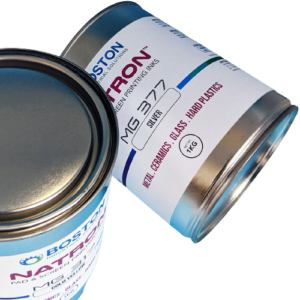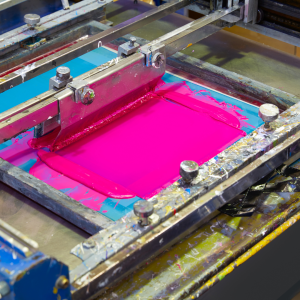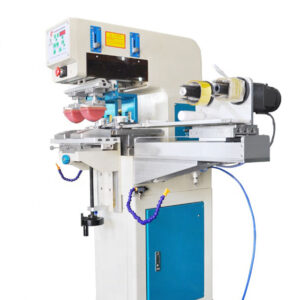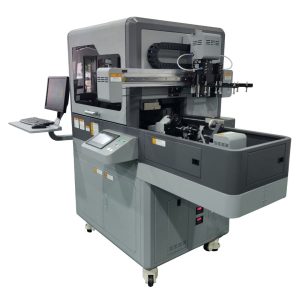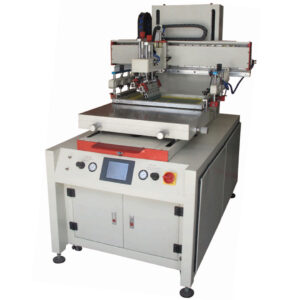How to print on silicone rubber
Printing on silicone rubber is challenging due to the unique properties of silicone rubber. Many decorators and contract printers ask, “How do you print on silicone?” In this article, we will review the unique silicone properties that make it hard to print on silicone. Additionally, we will review how to print on silicone rubber, the printing techniques (silicone screen printing and silicone pad printing), and inks for printing on silicone.
Challenges for conventional printing methods
Below are the reasons why it is challenging to print on silicone rubber using conventional methods.
- Non-porous, this rubber material does not readily absorb liquids, which makes it impossible for solvent-based, water-based, and oil-based inks to bond to silicone.
- The flexibility of silicone makes it impossible for conventional inks to print on the material. When solvent-based screen and pad printing ink dry, they become brittle. When these inks stretch, they peel, crack, or fade over time.
- Lastly, the low surface energy of silicone rubber affects the wettability of its surface. As a result, common solvent-based inks do not spread evenly, which causes poor printability and adhesion.
Overcoming these challenges often involves using specialized silicone-based inks. In addition to the inks, possible printing technologies for silicone rubber include pad printing and screen printing. Therefore, it is important to choose the right ink and printing method to ensure successful printing on silicone.
Ink to print silicone rubber
As discussed above, silicone’s unique properties make it hard to print. For these reasons, UV-curable ink, standard solvent-based screen, and pad printing inks will not adhere to silicone. To print silicone rubber, the only ink that sticks to silicone is silicone-based ink. Silicone inks require heat to dry and cure. Boston Industrial Solutions, Inc., offers excellent ink options for decorating silicone products. These are the SE, DC, and SE-F series. The SE Series is the most common non-medical silicone product. For medical silicone products, use the SE-F Series. Both series have high opacity, gloss, and flexibility compared to other inks on the market. Additionally, these inks have a high resistance to scratching and chemicals.
Lastly, for silicone products sensitive to heat, use the DC series.
How to Print Silicone Rubber
The process for silicone pad printing is like solvent ink pad printing. The decorator (printer) mixes the ink with a catalyst and solvent. Generally, the catalyst ratio is 10% of the ink weight. The silicone thinner ratio ranges from 10 to 70%, depending on the color and desired ink viscosity. Finally, the operator pours the ink mixture into an ink cup, loads it onto the pad printer, and starts printing. To dry the prints, dry and cure the images using heat. The amount of time and temperature needed to dry a silicone print depends on the density of the silicone substrate.
Additionally, we recommend using laser plates over photopolymer pad printing plates. Use 35–50-micron-deep plates. This depth will provide the best opacity while preventing the ink from splashing when printing on a silicone item.
Silicone pad printing supplies include a silicone pad printing machine, pads, plates, ink to print silicone rubber, and an ink cup. Additionally, we recommend having ink mixing sticks and lint-free towels. All these supplies are necessary to successfully print rubber.
A silicone printing pad is another important pad printing supply. We recommend 60–70 durometer pad printing pads for most silicone items. When printing silicone cups, use a 50-durometer pad.
Lastly, printing on this rubber with a pad printer offers the flexibility to print on otherwise difficult-to-print 3D surfaces.
If you still have any questions on what printer, inks, or pads to use for printing on your products, contact us at (781) 281-2558; we’d love to help you.
Multi-color printing on silicone rubber
Silicone ink requires heat to dry. As a result, the ink will remain wet until it is properly cured. Unlike solvent-pad printing inks, the printer must dry each image before printing the next image. For this reason, when printing multi-colors, it is important to use tight (exact) registration. Additionally, using the appropriate silicone solvent, e.g., TRM or TxM, will produce high-quality images. With TxM solvent, it is possible to print hundreds of images before cleaning the silicone pad.
Not sure when to change your pad printing pad? This article discusses when to change your printing pads.
Screen printing with silicone ink
Screen printing uses a squeegee to push ink through mesh onto a substrate, except in blocked areas of the screen. The screen mesh varies depending on the type of graphic used. For fine-detail artwork, use a 280–305 mesh. For bold logos, use 230–250 mesh-count screens. The higher the mesh count, the finer the details it is possible to print. The opposite is true. Also, the choice of the 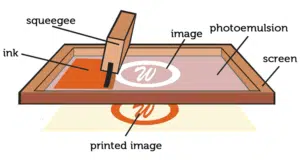
Like pad printing, mix silicone screen printing ink with the catalyst and solvent. The catalyst ratio is 10% of the ink weight. Use TRM solvent at a ratio of 5–10%. We also offer a retardant Type SS silicone solvent.
Lastly, consider the Volta S300C cylinder screen printing machine for printing silicone cups, silicone tumblers, and silicone pint cups.
Silicone ink costs per print.
It costs $0.015 to print a 1” x 1” (25mm x 25mm) image using a 305-screen mesh or a pad printing plate with 35 microns deep etch. Interested in printing on glass?
Boston Industrial Solutions’ screen and pad printing ink
At Boston Industrial Solutions, Inc., we offer the SE Series screen and pad printing ink. This series is flexible, chemical-resistant, and permanently bonds to the silicone substate. As mentioned above, we use pure silicone to make our silicone ink lines. The SE Series meets and exceeds all the criteria required by printing industry standards. The Natron SE Series has high opacity, gloss, flexibility, fade resistance, RoHS, CPSIA, etc. Additionally, this ink for printing on silicone rubber comes in 40 standard colors. Additionally, we offer custom ink color matching services. All custom colors are available within a day upon request.
For heat-sensitive silicone products, we offer the DC Series silicone ink. This ink cures at a lower temperature compared to the SE series. Unlike the SE series, this ink has less opacity and is lighter in weight. We recommend this ink for items that will not undergo lots of abrasion and in applications where silicone is bonded with plastic.
The SE-F Series silicone ink is the best silicone ink for medical-grade silicone products. This ink uses the purest silicone polymers and ultrapurification to make sure that there are no impurities. This ink features medical Class VI certification. Printing methods for this ink series include both screen and pad printing. We have over 20 standard colors for the SE-F series, and custom colors are available upon request.
Silicone substrates
Silicone substrates are becoming popular as many companies look for alternatives to plastic. Many industries, including promotional, sporting goods, industrial, electronics, aerospace, automotive, etc., prefer silicone due to its feel, durability, inertness, and sustainable properties. With our silicone rubber inks, you can print on any silicone product, such as swim caps, drinkware, tool handles, remote control buttons, dog bowls, etc. Visit our printing applications page to learn more about the popular silicone printing applications.
Which printing technology should you use to print onto silicone: printing vs. pad printing?
Both screen and pad printing are excellent options for printing on silicone. There are trade-offs for choosing one printing method over the other.
The shape of the object determines which printing method to use. For odd-shaped products, use pad printing. Additionally, pad printing is excellent for small logos that are less than 90° around the object. If you need to print on tapered-shaped or 360° cylindrical objects, such as cups, we recommend screen printing. Screen printing is also excellent when printing bold images. In general, pad printing lays down more ink compared to pad printing. This leads to higher opacity and glossy prints compared to pad printing.
It is possible to print multiple colors with both printing methods. However, you must dry and cure each color after printing. Use laser guides and tight registration tooling fixtures. These will enable you to successfully print multiple colors on silicone.
A key advantage of pad printing is the ability to reuse the ink. It is possible to store the ink-catalyst-solvent mixture in the sealed ink without any impact on the ink for 24 hours. This reduces the cost of the ink compared to screen printing. For screen printing, it is important to clean the screens at the end of the screen or run the risk of damaging the screens.
Overall, both printing methods are excellent for printing. The type of product will dictate the printing process. Additionally, for startups, when choosing the type of equipment, it is important to consider future printing products. Ready to start printing on silicone? Here are the top 7 applications to print on silicone rubber with silicone ink.
Lastly, learn more about our other printing inks, including UV printer ink, solvent-based inks, and UV adhesion promoters.


